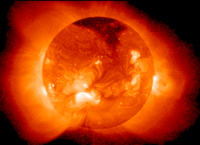
Photo from wikipedia
Abstract Overpressurization of intergranular fission gas bubbles and pores in oxide fuel pellets may occur in nuclear reactor accidents that involve rapid overheating of the fuel. The overpressurization leads to… Click to show full abstract
Abstract Overpressurization of intergranular fission gas bubbles and pores in oxide fuel pellets may occur in nuclear reactor accidents that involve rapid overheating of the fuel. The overpressurization leads to fine fragmentation of the pellets and burst-type release of fission gas from the shattered material. Since these phenomena may worsen the radiological consequences of reactor accidents, they have been extensively studied in the past, both by experiments and modelling. A key element in the modelling is the formulation of an appropriate analytical criterion, by means of which fragmentation of the material can be predicted based on the size, shape, number density and internal pressure of the gas filled cavities. This work is a critical review and assessment of seven existing criteria of this kind. The assessment reveals significant differences among the criteria. Most of them exhibit unphysical trends with regard to key parameters and/or give results that contradict observed fuel behaviour. Only two of the assessed criteria are deemed suitable for use in computer programs intended for analyses of the thermal–mechanical behaviour of light water reactor fuel rods in accident conditions, such as RIA and LOCA. In addition, it is shown that one of the five deficient criteria can be turned useful by a slight re-formulation.
Journal Title: Progress in Nuclear Energy
Year Published: 2020
Link to full text (if available)
Share on Social Media: Sign Up to like & get
recommendations!